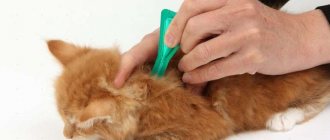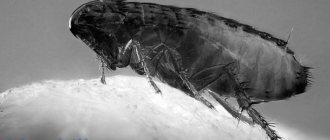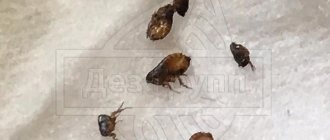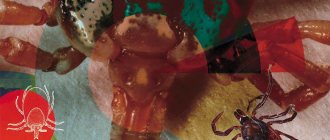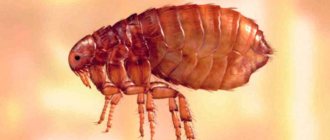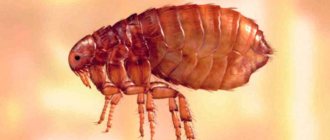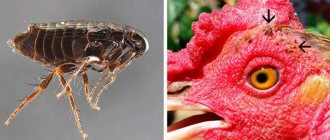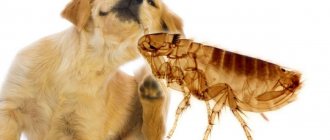Flea infestation in cats is a common and quite unpleasant phenomenon, so it is imperative to combat it. And to prevent re-infection, you need to know how quickly fleas reproduce.
Let's find out what the life expectancy of these insects is and how to properly treat the disease so that you don't have to resort to serious measures.
Flea development: from egg to adult
Fleas are insects with complete metamorphosis. That is, at each stage of development, the insect has a different morphology and appearance.
Egg maturation
Like other insects, the life of a flea begins with the maturation of eggs.
The eggs of the parasite are oval-shaped, transparent or white, no more than 1 mm, and resemble tiny grains of rice in appearance. Females lay about 20 eggs per day. The ripening period depends on external conditions:
- temperature,
- air humidity.
Under favorable conditions, the larvae hatch on the second day; under unfavorable conditions, the process slows down and lasts for 3–4 weeks.
Larval stage
The larva is an almost transparent worm, the body is covered with thin hairs. As the larva develops, it grows up to 5 mm in length.
They can hardly be called parasites, since the larva does not need a feeder. It feeds on organic matter: dried blood, epidermis and excrement of adult insects. Therefore, a flea at this stage cannot be found in animal fur.
Their life also requires special conditions:
- air temperature 25 °C,
- humidity - 60%.
At higher temperatures and low humidity, the insect dries out. In addition, the larvae are very sensitive to light and therefore instinctively try to find an unlit place.
Pupation
After three molts (after about 2 weeks), the insect forms a cocoon, enveloping itself in a thin silk layer. This happens in a secluded and safe place. The walls of the cocoon protect the insect from external influences and help camouflage itself. Externally, the pupa resembles a small speck.
The pupation stage can take from 14 days to 1 year, depending on conditions. On the outer layer of the cover there are receptors that determine the temperature and humidity of the air, as well as the location of a potential breadwinner based on the level of carbon dioxide exhaled by animals. Under favorable conditions, an adult flea emerges from the pupa.
During the Middle Ages, cats were believed to have a connection with the devil because they carried fleas. In this regard, people began to get rid of these animals. But this led to the proliferation of rats, which had their own special fleas, which, in turn, contributed to infection with bubonic plague.
Features of an adult
The size of an adult does not exceed 5 mm. The flea is flattened on the sides, its body is covered with bristles and combs, which help to cling tightly to the hair on the body of the feeder. These insects do not have wings, and strong and long hind legs help them overcome long distances. The oral apparatus consists of stylets that bite through the skin and a proboscis that drinks blood from the vessels.
The lifespan of an adult flea varies from a month to 2 years.
How do fleas reproduce in cats?
- As a rule, fleas reproduce with the help of larvae, which they lay on the animal's body, in its bedding and in its surrounding areas. Parasites are able to adapt to any danger, so their reproduction does not depend on the conditions in which the pet is located.
- One adult lays about 8 eggs at a time. The insect can live a fairly long life, so during this period the number of eggs can reach as many as 500. This number of larvae is enough for the cat to experience very severe suffering.
- Fleas leave their eggs not only in animal fur or on the carpet. Dust can become a similar object, especially if you do not clean regularly. And also carefully analyze the room for the presence of various holes, you can find a very large number of larvae there.
- Flea larvae look like very small worms that can move very quickly. From birth, they begin to feed on various wastes that remain as a result of the vital activity of adult fleas. With constant nutrition, small individuals begin to grow and molt, which occurs several times in a row. After 3 molts, a fully formed insect appears.
The complete development of a flea to an adult state occurs in approximately 4 weeks. Therefore, those who are interested in the proliferation of fleas in cats should be aware of this in order to prevent colonies of insects from appearing in their home or in the fur of their pet.
The photo shows flea feces.
Flea reproduction
Once the flea emerges from the cocoon, it can reproduce. All types of fleas reproduce the same way. Mating can occur both on the body of the breadwinner and outside it.
Fleas have genitals:
- in the female - ovaries, uterus and spermatic receptacle,
- the male has two testes and a genital claw.
The female climbs onto the male's back and takes the genital claw into the spermatheca. The process can take from 30 minutes to 2 hours. Immediately after copulation, the female needs to feed on blood.
The male participates in reproduction once - this is enough for the female to give birth to offspring for the rest of her life, which is at least 400 eggs.
Fleas do not lay eggs in special places, but shoot them out of the abdomen under pressure, thereby expanding the area of distribution. The eggs are not covered with adhesive substances, so they roll freely over the fur and skin without getting stuck anywhere.
Anatomy of a parasite
The male individual has two testes, which end in a claw (genital claw), which is where the seminal fluid flows. The anatomy of the female is a little more complicated. In addition to one or two pairs of ovaries, the female has oviducts at the junction of the uterus. The mating process is quite long. In order for fertilization to occur, the female climbs onto the male and literally sucks the partner’s genital claw, which is located on his back.
The process of absorption of seminal fluid into the female’s body takes approximately 15 minutes, and mating itself can last up to several hours.
Mating is accompanied by the laying of eggs. The female lays a small amount, about 5-10 at a time. Laying is impossible when the insect is hungry. If she is full, it is likely that she will be able to put off several batches during the day. It should be noted that throughout its life this insect can lay up to 500 eggs.
Certain conditions are necessary for the development of larvae. Usually, a large number of them can be seen in domestic animals , so the appearance and reproduction of fleas in the house is not surprising, because the fur of pets is one of the most favorable places for the development of insects.
How to fight fleas in an apartment, watch the video:
Read on topic:
Symptoms of chicken fleas and treatment methods for birds
20.05.2019
How to interpret a dream if there was a flea in the vision
14.05.2019
The likelihood of fleas in pet hamsters
10.05.2019
How to identify sand fleas and is it possible to get rid of them?
10.05.2019
Lifespan of fleas
The average lifespan of a parasite is 3–4 months. But everything depends on external conditions:
- air humidity,
- air temperature,
- availability of food.
If fleas are infested in an apartment where there is no control over them or pets, the lifespan is not reduced. In the absence of animals, fleas do not disdain human blood, even if they are representatives of the dog and cat families. In addition, parasitism on dogs and cats, on the contrary, is more dangerous for them - animals have instinctive cleanliness and kill parasites by gnawing with their fangs and combing.
Fleas can live without food for 4–5 months. They do not slow down their development, but they stop producing offspring. However, cat fleas are known for discarding insects that starve to death within 12 hours (males) and 96 hours (females).
The survival rate of insects also depends on a number of accidents:
- according to statistics, less than half of the eggs laid by one insect survive the full cycle of transformation,
- some eggs and adult insects can be eaten by the breadwinner,
- Eggs are laid at any time of the day and at any moment. Therefore, they can find themselves either indoors and warm, or on a cold frosty street where it is impossible to survive. If the eggs end up in a place where the future larva has nothing to feed on and a lot of sunlight, then the insect also has no chance of surviving.
Lifespan
Life expectancy again depends on the conditions and type of the flea itself. It is worth noting that these insects are able to survive in unfavorable conditions in the pupal state. Even being at the last stage of development, the imago can remain in the pupa until better times. Then the full life of an adult begins , which can last from 4 to 18 months. The most common life expectancy of a flea is 6 months.
The lifespan of a flea depends on the conditions under which it lives.
Insects feel great at temperatures of +21…+30°C. An increase in temperature has a negative effect on them: fleas die. As for temperatures that may be below +20°C, the insect tolerates it much more easily; the process of development of the pupa may just slow down.
Insect habitats
Fleas do not live on the animal itself. Insects prefer to settle next to a potential breadwinner: in caves, nests and burrows of animals and birds. This is necessary in order to have free access to food and drink blood at any time.
It is much easier for insects to survive in an apartment or residential building. Their habitats may be:
- bedding and resting places for pets (houses, mattresses, baskets),
- floor cracks, baseboards and carpets,
- bed sheets,
- deposits of clothes,
- furniture, bed mattresses,
- storage areas for vegetables or garbage.
The eggs fall to the floor directly from the animal, so they can end up anywhere, but the most common habitats are those that are closer to the owner - the bed and carpets.
Signs of the presence of fleas in the apartment
Parasites do not live permanently on their “hosts”. Having eaten, they jump off the pet and settle in the house. In an apartment, fleas can be found behind old furniture, under carpets, in cluttered corners or rooms, and in cracks in the floor.
The fact that parasites have settled in the house can be recognized by bites, which are characterized by the following symptoms:
To prevent the bite from itching and inflammation in its place, it is recommended to treat the wound with an antiseptic, cool it with ice or vinegar and lubricate it with anti-itch ointment.
You can tell if your pet has fleas by its behavior:
At the early stage of infection of an animal, parasites live on the tailbone, stomach and head. They also like to live in the intermaxillary space and neck.
Flea eggs: description
Flea eggs are small in size, similar to grains of salt, and white in color. They develop at high temperatures in just a few days. Under normal conditions, from a week to two. Optimal conditions for flea larvae are temperatures between 20 and 27 degrees Celsius and humidity around 65%. In any other state of the external environment, fleas tend to fall into a kind of suspended animation. Therefore, their development can last from several days to several years.
The same thing happens with pupae, which, unlike eggs, can withstand lower temperatures. However, they love warmth, and can also spend several years in a state of development if conditions are unfavorable.
In fact, flea reproduction can occur without animals. If there is a male flea and a female flea in your house, then they can produce “children” even in the absence of cats, dogs and other living creatures. Fleas also do not have a breeding season. They mate when the male finds a female, or vice versa. This can happen at any time of the year.
The process of egg maturation occurs directly in the flea's body.
